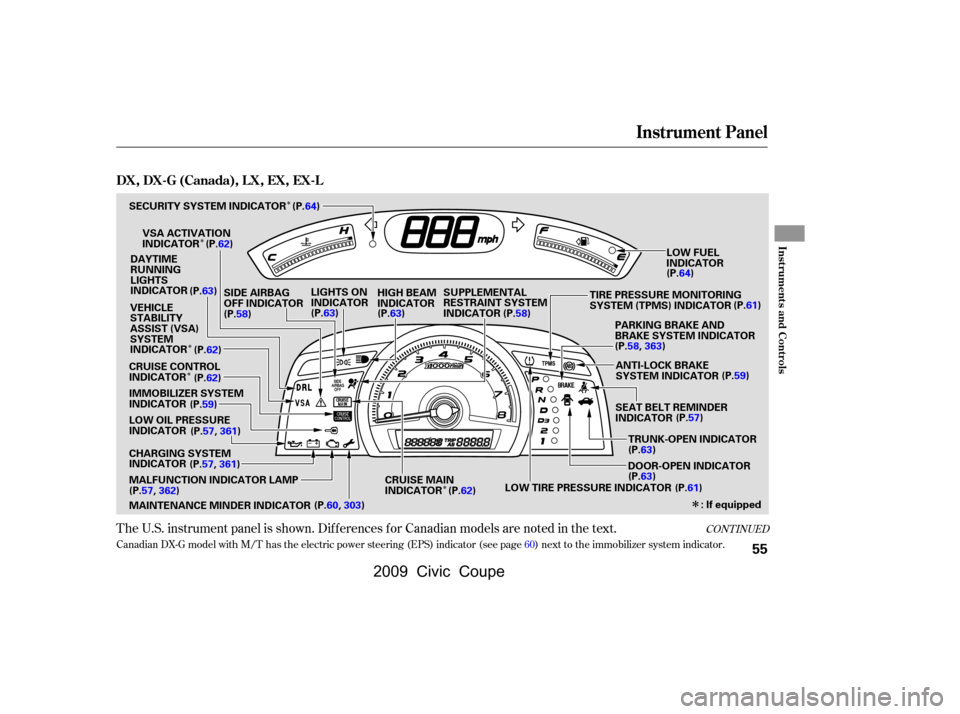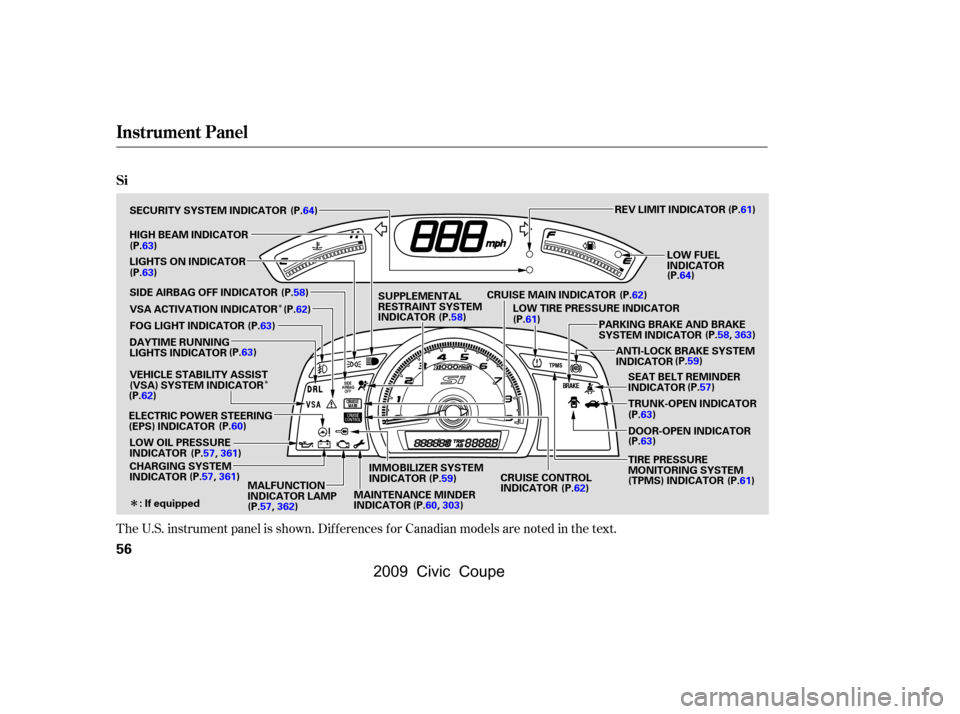Page 58 of 412

�Î
�Î �Î
�Î �Î
�Î
CONT INUED
Canadian DX-G model with M/T has the electric power steering (EPS) indicator (see page60) next to the immobilizer system indicator.
The U.S. instrument panel is shown. Dif f erences f or Canadian models are noted in the text.
Instrument Panel
Inst rument s and Cont rols
DX,DX-G(Canada),LX,EX,EX-L
55
LOW FUEL
INDICATOR
SUPPLEMENTAL
RESTRAINT SYSTEM
INDICATOR
SEAT BELT REMINDER
INDICATORANTI-LOCK BRAKE
SYSTEM INDICATOR
SECURITY SYSTEM INDICATOR
(P.63)(P.57)
(P.64)
(P.58) PARKING BRAKE AND
BRAKE SYSTEM INDICATOR
(P.59)
TRUNK-OPEN INDICATOR
(P.63)
DOOR-OPEN INDICATOR
(P.61)
LOW TIRE PRESSURE INDICATOR
(P.64)
TIRE PRESSURE MONITORING
SYSTEM (TPMS) INDICATOR(P.61)
HIGH BEAM
INDICATOR
(P.63)
LIGHTS ON
INDICATOR
(P.63)
: If equipped
SIDE AIRBAG
OFF INDICATOR
(P.58)
(P.59)
(P.63)
(P.62)
(P.62)
DAYTIME
RUNNING
LIGHTS
INDICATOR
VEHICLE
STABILITY
ASSIST (VSA)
SYSTEM
INDICATOR
CRUISE MAIN
INDICATOR
IMMOBILIZER SYSTEM
INDICATOR CRUISE CONTROL
INDICATOR
CHARGING SYSTEM
INDICATOR LOW OIL PRESSURE
INDICATOR VSA ACTIVATION
INDICATOR
MALFUNCTION INDICATOR LAMP
MAINTENANCE MINDER INDICATOR (P.62)
(P.62)
(P.57,361)
(P.57,361)
(P.57,362) (P.60,303) (P.58,363)
�����—�����—�����y�
�������������y���
�(�+���������y���������y
2009 Civic Coupe
Page 59 of 412

�Î
�Î�Î
The U.S. instrument panel is shown. Dif f erences f or Canadian models are noted in the text.
Instrument Panel
Si
56
REV LIMIT INDICATOR
DOOR-OPEN INDICATOR
ANTI-LOCK BRAKE SYSTEM
INDICATOR
SEAT BELT REMINDER
INDICATOR
TRUNK-OPEN INDICATOR
CHARGING SYSTEM
INDICATOR
ELECTRIC POWER STEERING
(EPS) INDICATOR DAYTIME RUNNING
LIGHTS INDICATOR
SECURITY SYSTEM INDICATOR
LIGHTS ON INDICATOR
SUPPLEMENTAL
RESTRAINT SYSTEM
INDICATOR
HIGH BEAM INDICATOR
: If equipped PARKING BRAKE AND BRAKE
SYSTEM INDICATOR
LOW FUEL
INDICATOR
(P.63)
(P.63)
(P.63)
VEHICLE STABILITY ASSIST
(VSA) SYSTEM INDICATOR
(P.62)
(P.60)(P.64)
(P.61)
(P.64)
CRUISE MAIN INDICATOR LOW TIRE PRESSURE INDICATOR
MALFUNCTION
INDICATOR LAMP IMMOBILIZER SYSTEM
INDICATOR (P.62)
(P.61)
(P.59)(P.57)
(P.63)
(P.63)
(P.58)
(P.61)
(P.62)
MAINTENANCE MINDER
INDICATOR (P.59)
CRUISE CONTROL
INDICATOR TIRE PRESSURE
MONITORING SYSTEM
(TPMS) INDICATOR
SIDE AIRBAG OFF INDICATOR (P.58)
(P.62)
FOG LIGHT INDICATOR
VSA ACTIVATION INDICATOR
(P.63)
LOW OIL PRESSURE
INDICATOR (P.57,361)
(P.57,361)
(P.57,362) (P.60,303) (P.58,363)
�\f���—�\f���—�\f���y�
�\f����
��\f���y���
�(�+�������\f�y�\f�\f���
�y
2009 Civic Coupe
Page 63 of 412

If you turn the steering wheel to the
f ull lef t or right position repeatedly
while stopping or driving at very low
speed, you may f eel slightly harder
steering due to overheating of the
steering gearbox.
Continuously driving under those
conditions could damage the power
steering system.This indicator comes on f or a f ew
seconds when you turn the ignition
switch to the ON (II) position. It
remindsyouthatitistimetotake
your vehicle in f or scheduled
maintenance. The maintenance main
items and sub items will be displayed
in the information display. See page
f or more inf ormation on the
maintenance minder.
This indicator goes of f when your
dealer resets it after completing the
required maintenance service.
This indicator normally comes on
when you turn the ignition switch to
the ON (II) position and goes of f
af ter the engine starts. If it comes on
at any other time, there is a problem
in the electric power steering system.
If this happens, stop the vehicle in a
saf e place, and turn of f the engine.
Reset the system by restarting the
engine. The indicator will not turn
of f immediately. If it does not go of f
after driving a short distance, or
comes back on again while driving,
take the vehicle to your dealer to
have it checked. With the indicator
on, the EPS may be of f , making the
vehicle harder to steer.
303
Instrument Panel Indicators
Electric Power Steering
(EPS) Indicator
Maintenance Minder
Indicator
Si and Canadian DX-G with manual
t ransmission models
60
�\f���—�\f���—�\f���y�
�\f����
������y���
�(�+�������\f�y�\f�\f�����y
2009 Civic Coupe
Page 68 of 412
�Î
�Î
To switch the information display
between the odometer, trip meter,
and outside temperature (if
equipped), and engine oil lif e and
maintenance service items, press the
SEL/RESET button repeatedly.
If equipped
:
Gauges
Inst rument s and Cont rols
65
SPEEDOMETER
TRIP METER INFORMATION
DISPLAYFUEL
GAUGE
TACHOMETER
TEMPERATURE GAUGE
SEL/RESET BUTTON
ODOMETER/OUTSIDE
TEMPERATURE INDICATOR
U.S. EX-L model with A/T is shown.
�\f���—�\f���—�\f���y�
�\f�����������y���
�(�+�������\f�y�\f�\f���\f�y
2009 Civic Coupe
Page 72 of 412
The inf ormation display in the
instrument panel shows you the
engine oil lif e and maintenance
service items when the ignition
switch is in the ON (II) position. This
inf ormation helps to keep you aware
of the periodic maintenance your
vehicle needs f or continued trouble-
f ree driving. Ref er to page f or
more inf ormation.
If the system still detects a leak in
your vehicle’s evaporative emissions
system, the malf unction indicator
lamp (MIL) comes on. If the f uel f ill
cap was not already tightened, turn
the engine of f , and check or
retighten the f uel f ill cap until it
clicks at least once. The MIL should
go off after several days of normal
driving once the cap is tightened or
replaced. If the MIL does not go of f ,
have your vehicle inspected by a
dealer. For more inf ormation, see
page .
362 303
Maintenance Minder
Gauges
Inst rument s and Cont rols
69
�\f���—�\f���—�\f���y�
�\f�����������y���
�(�+�������\f�y�\f�\f�����y
2009 Civic Coupe
Page 267 of 412

Help assure your vehicle’s f uture
reliability and perf ormance by paying
extra attention to how you drive
during the f irst 600 miles (1,000 km).
During this period:Avoid full-throttle starts and rapid
acceleration.
You should also f ollow these
recommendations with an
overhauled or exchanged engine, or
when the brakes are replaced. Avoidhardbrakingforthefirst
200 miles (300 km).
Do not change the oil until the
scheduled maintenance time. We recommend using quality
gasolines containing detergent
additives that help prevent fuel
system and engine deposits.
In addition, in order to maintain good
perf ormance, f uel economy, and
emissions control, we strongly
recommend, in areas where it is
available, the use of gasoline that
does NOT contain manganese-based
f uel additives such as MMT.
Use of gasoline with these additives
may adversely af f ect perf ormance,
and cause the malfunction indicator
lamp on your instrument panel to
come on. If this happens, contact
your authorized dealer f or service.
Your vehicle is designed to operate
on unleaded gasoline with a pump
octane number of 87 or higher. Use
of a lower octane gasoline can cause
a persistent, heavy, metallic rapping
noise that can lead to engine damage.
Your vehicle is designed to operate
on premium unleaded gasoline with a
pump octane number of 91 or higher.
Useof aloweroctanegasolinecan
cause occasional metallic knocking
noises in the engine and will result in
decreased engine perf ormance. Use
of a gasoline with a pump octane
number less than 87 can lead to
engine damage.
Break-in Period Fuel Recommendation
Break-in Period, Fuel Recommendation
A ll models except Si
Si model only
264
�\f���—�\f���—�\f���y�
�
����\f��
���y���
�(�+�������\f�y�\f�������y
2009 Civic Coupe
Page 272 of 412
Look at the coolant level in the
radiator reserve tank. Make sure it is
between the MAX and MIN lines. If
it is below the MIN line, seeon page f or
inf ormation on adding the proper
coolant. Refer to
on page f or inf ormation
about checking other items on your
vehicle.
316 308
A dding
Engine Coolant Owner’s Maintenance
Checks
Engine Coolant Check
Service Station Procedures
Bef ore Driving
269
RESERVE TANK
SiRESERVE TANK
MAX
MIN
MAX
MIN
DX, Canadian DX-G, LX, EX, EX-L
�\f���—�\f���—�\f���y�
�
����\f������y���
�(�+�������\f�y�\f�������y
2009 Civic Coupe
Page 274 of 412

�µ�µ
�µ �µ
�µ
�µ�µ
Aggressive driving (hard
acceleration and braking)
Excessive idling, accelerating and
braking in stop-and-go traf f ic
Cold engine operation (engines
aremoreefficientwhenwarmed
up)
Driving with a heavy load or the
air conditioner running
Improperly inf lated tires
The f ollowing f actors can lower your
vehicle’s f uel economy:
A properly maintained vehicle
maximizes f uel economy. Poor
maintenance can signif icantly reduce
f uel economy. Always maintain your
vehicle according to the maintenance
messages displayed on the
inf ormation display (see
on page ).
For example: Rapid
acceleration, abrupt cornering,
and hard braking increase fuel
consumption.
Aerodynamic drag has a big ef f ect
on f uel mileage at speeds above 45
mph (75 km/h). Reduce your
speed and you reduce the drag.
Trailers, car top carriers, roof
racks and bike racks are also big
contributors to increased drag.
If your vehicle has a
manual transmission, you can
boost your f uel economy by up
shif ting as early as possible.
Idling
results in 0 miles per gallon.
An underinf lated tire increases
‘‘rolling resistance,’’ which reduces
f uel economy.
It puts a heavier
load on the engine, increasing f uel
consumption.
In
particular, a build-up of snow or
mud on your vehicle’s underside
adds weight and rolling resistance.
Frequent cleaning helps your f uel
economy.
308
CONT INUED
Fuel Economy
Fuel Economy Factors Use the recommended viscosity motor oil, displaying the A PI
Certif ication Seal (see page
).
Improving Fuel Economy Owner’s
Maintenance Checks Drive moderately
Observe the speed limit
Always drive in the highest gear
possible
Avoid excessive idling
Maintain proper tire inf lation
A void carrying excess weight in
your vehicle
K eep your vehicle clean
312
Vehicle Maint enance Drive Ef f icient ly
Bef ore Driving
271
�\f���—�\f���—�\f���y�
�
����
��
���y���
�(�+�������\f�y�\f�������y
2009 Civic Coupe